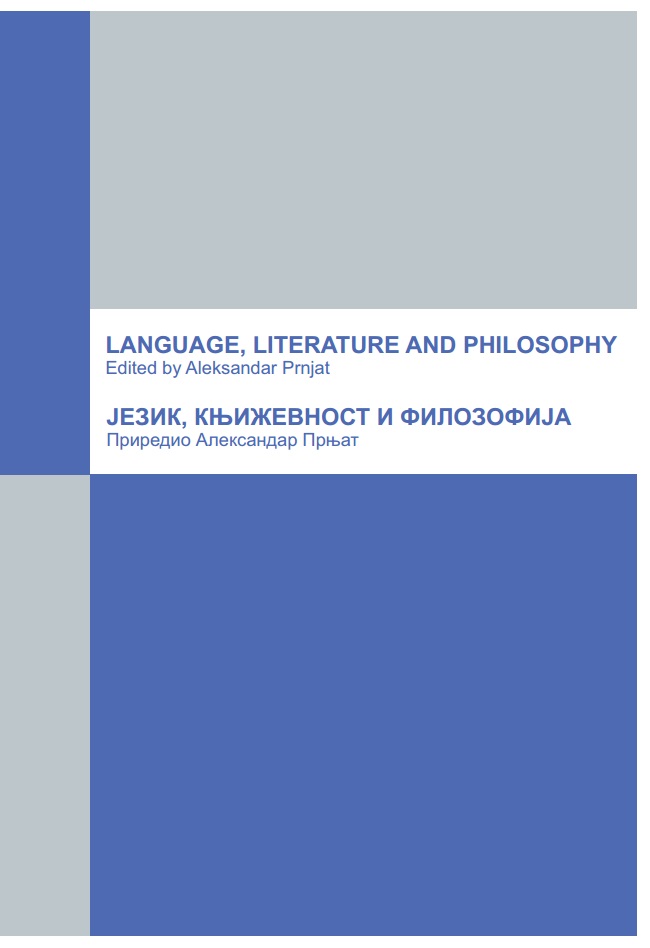
We kindly inform you that, as long as the subject affiliation of our 300.000+ articles is in progress, you might get unsufficient or no results on your third level or second level search. In this case, please broaden your search criteria.

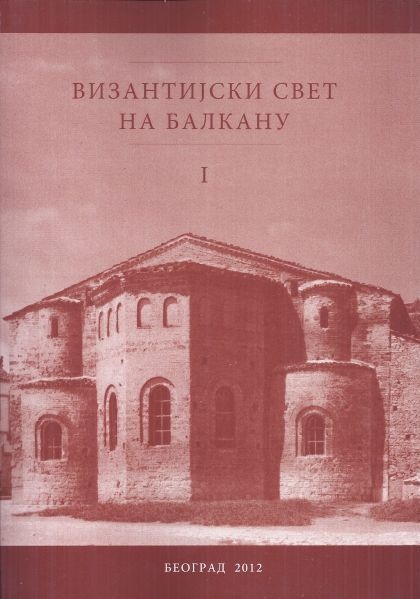
The church of Saint Sophia in Ohrid was built by Archbishop Leo (1037–1056), “the first of the Greek” since the founding of the Archbishopric of Ohrid (1019), on the site of an older church. On the model of the cathedral church of the Patriarchate of Constantinople, he dedicated the church to St. Sophia, and its chapels to the Forty Martyrs of Sebaste, Saint John the Baptist and the Holy Apostles, whose relics are kept in their Constantinople church. No doubt, the painters were brought from the capital, as well; certain scenes distinctive of Constantinople art were also painted in St. Sophia, again probably by the intervention of Archbishop Leo. His imprint is most perceptible in the decoration of the sanctuary. Certain dogmatic-liturgical themes are presented there, whose iconography coincides for the most part with Leo’s viewpoints expressed between 1052 and 1054 in his epistles addressed to Bishop John of Trani, and also the entire Western clergy including the Pope. In his polemic with the West, the Archbishop of Ohrid drew mostly from the Pauline epistles and argued that leavened bread was the only true body of Christ, and as such needed to be used in the Eucharist. There is, therefore, very little doubt why the Eucharist should be painted in the apse of the church in Ohrid instead of the Communion of Apostles. This image contains subtle iconographic meanings, very closely related to the theological discussions of the time. Two scenes from the north wall are also connected to the Communion of Apostles: the Vision and the First Service of Saint Basil, depicting the origin of Byzantine liturgy. It stems from Christ and the Apostles, for it was Christ who inspired St. Basil to compose his Liturgy, which Basil himself served in the sanctuary immediately thereafter. It was probably Leo again who had the eminent Greek hierarchs gathered around St. Basil and St. John Chrysostom painted in the apse, along with several scenes from the Old Testament prefiguring the Incarnation and the New Testament service. There is no doubt that Archbishop Leo is to be further accredited with the representations of the great number of holy bishops and with their order. They served to assert the primacy of the Patriarchate of Constantinople which constituted the center of all the local Orthodox churches. This ideal image of Christian ecumenism also included the Western Church, which was represented by the images of Roman Popes honored by the Byzantine world. Furthermore, Leo accounted for the origin of his Archbishopric by the portraits of the popes Innocent and Vigilius who recognized the autocephaly of the Vicariate of Thessaloniki and Justiniana Prima, Church organisations preceding first the Bulgarian, and then the Archbishopric of Ohrid. The Bulgarian Church — the second component which led to the creation of the autocephaly of the Archbishopric of Ohrid — was presented in the Ohrid fresco-painting by the images of SS. Cyril and Clement, whereas the constitution of the Archbishopric of Ohrid was represented by the portrait of Patriarch Eusthatius (1019–1025), during whose time the Archbishopric was established. Taking all of this into account, one should regard Archbishop Leo as the real creator of the fresco programme in St. Sophia in Ohrid: he authorized it, but also propagated certain themes which he found particularly important. Those were associated with liturgy, the issue of communion bread, the relationship between the Patriarchate of Constantinople and Rome, as well as with the autocephaly of the Archbishopric of Ohrid. The frescoes are permeated with references to the events at the time of the Great Schism, in which Archbishop Leo played one of the most important roles. Today, without the historical context it would be hard to understand the frescoes in Ohrid and their iconography. Therefore, the frescoes should be dated between the years 1052, the start of the polemic with Rome and 1056, the passing of Archbishop Leo. In his cathedral church, he not only created a first-rate work of art, but also an artwork which marks the threshold of a new era in Byzantine art after 1054.
More...
The countenance and role of portraits on the partly preserved fresco in St. Sofia church in Ohrid showing manifestation of Divine Wisdom have been differently interpreted. Starting from the hagiography of St. Basil the Great, some art historians have interpreted this fresco as Christ’s and holy Apostle’s epiphany to St. Basil the Great, who is being called to the service in the holy altar. Other art historians have envisaged the composition in a wider context, primarily pointing to a special place of St. Paul in the apostolic choir, as well as to a special bond between Paul the Apostle, the most meritorious New Testament herald of the Holy Wisdom, and his best hermeneutist, St. John Chrysostom. It is certain that the painter of the St. Sofia Church found an inspiration for the presentation of Holy Wisdom in sophiological texts of the Old Testament, in St. Paul’s epistles as well as in the testimonies of St. Proclus of Constantinople re corded in the Hagiography of St. John Chrysostom. The representation of the Holy Wisdom as a girl stems from the tradition relying on the King Solomon’s tales, in which the Holy Wisdom builds a home and summons people to eat bread and wine she has prepared (9, 1–5). In this context, the representation of the Holy Wisdom should not be interpreted regardless of the image of Jacob’s ladder, since this representation, being placed in the altar symbolizing Heaven, makes present the very incarnation of the Son who came down from Heaven (John 3, 13). The liturgical context of Holy Wisdom representation is underlined by the image of St. Basil the Great, certainly the most significant Divine Liturgy maker/creator, beside St. John Chrysostom. Both of these compositions, the Jacob’s ladder and Service of St. Basil the Great, related to the epiphany of Holy Wisdom to St. John Chrysostom, enclose both aspects of “Divine Economy”: the coming of Christ into the world and his Eucharistic sacrifice in Liturgy. The position of Holy Wisdom in the altar suggests not only “symbolic interpretation of an exceptional rhetorical gift” nor just “Divine inspiration — a dream of St. John Chrysostom” since both the rhetorical gift and divine inspiration need the same life-giving source — the Holy Eucharist. The participation in the agape that Holy Wisdom prepared (as it is stated in the 3rd line of the 9th chapter of King Solomon’s tales) refers to, according to St. John of Damascus, ineffable future goods that Holy Wisdom would give to those who take her Body as their meaningful food and her Blood as their meaningful drink. The Holy Wisdom’s agape, which was prepared long before, in the words of St. Maximus the Confessor, is a final destination and purpose of the painting in the Church of St. Sofia in Ohrid.
More...
The fragments of three rulers’ images are preserved in the highest zone of the eastern wall of what is known as Gregory's Gallery in the exonarthex of the Ohrid cathedral. They are represented on each side of the images of the Deesis, with Christ on the throne, flanked by the images of two archangels, and two saints who mediate for the rulers. Based on the number of the ruler’s portraits, scholars assumed that these are the portaits of the Serbian emperor Dušan, his wife Jelena, and their son Uroš. Therefore, the mural paintings of the gallery are dated to the period between 1350 and 1355 because of the great stylistic similarity between the frescoes of the gallery and those on the first floor of the narthex which were painted by John Teoryanos and his assistants at the end of the fifth decade of the 14th century. One can reliably assume that the first ruler’s image from the left side of the north wall is, in fact, the portrait of the male member of the family. Such an assumption is based on the existence of the small fragment of an extremely long loros, a detail that was not observed by researchers. On the right side of the adjacent figure, a fragment of a semicircular decorative detail is preserved. This detail is reminiscent of the semicircular ornaments on the male sakkos. However, the possibility that the mentioned image is a portrait of the empress Jelena should not be excluded. Namely, one may think that the detail in question is, in fact, the fragment of a long, wide sleeve of a female ruler’s dress. Portraits of Jelena in Saint Nicholas Bolnički in Ohrid and in Lesnovo point to this conclusion. In addition, one should pay attention to the fact that the throne and the legs of Christ are intentionally directed to the south side. That is why we assume that the portait of Dušan was represented on that side, and the portraits of his son and wife who is nearer to Christ , were on the opposite, north side of the eastern wall of the gallery. Based on the existence of a supaedion, on which the figure nearest to Christ on the north side is standing, one can conclude that it is the image of the Virgin. The vertical decorative stripes on her dress are almost identical to those in the churches of Saint Demetrios in the Patriarchate of Pe}, Marko’s Monastery, Lesnovo and Konče. The assumption that the bishop represented on the opposite side of Christ should be identified as Saint Clement of Ohrid cannot be accepted without reserve. Namely, he was not represented with the long pointed beard that covers a part of his omophorion, as was the case on almost all of the images of Saint Clement. That is why the possibility that the image of some other holy bishop is in question seems more acceptable. One should especially examine the possibility that it was Saint Nicholas of Myra. Primarily, the only holy bishop that was represented in the Deesis in Eastern Christian iconography instead of Saint John the Forerunner was, as far as we know, just Saint Nicholas. As valid comparative examples, one can mention the images of the Deesis from the diakonikon of Sopo}ani, above the portal of the narthex of Saint Nicholas Domnesc in Kurtea de Arges, or the Deisis represented on the Russian icon from Tver, painted at the begining of the 16th century. It should be emphasized that Saint Nicholas was greatly respected during the reign of Dušan. This Serbian ruler had an almost personal attitude towards this saint and bishop. Evidence of this is Dušan’s gift to the basilica of Saint Nicholas in Bari, dedications of the smaller church of his mausoleum and the paraklession in Dečani, as well as from the texts of several of his charters. In some of the aforementioned documents, the mediating role of Saint Nicholas is especially stressed. Such a status was assigned to Saint Nicholas in the western part of the Dečani naos, as well. There is a “spatial Deesis” consisting of the figure of the Christ, the Virgin, Saint John the Baptist and Saint Nicholas. Finally, since Saint Nicholas was the namesake of the archbishop of Ohrid, there are grounds for assuming that it was the archbishop who wanted Saint Nicholas to be represented in the Deesis composition.
More...
The marriage provisions of the second charter of the Žiča monastery issued by King Stefan the First-Crowned and his son Radoslav (around the middle of the 1220s) are considered as a source for the research of the existing models of marriage in the society of medieval Serbia. Two of them could be recognized as primary models (according to George Duby) — the church and official model of marriage, prescribed in the royal charter and the popular or lay one, deeply rooted in the traditional medieval society. The intention of the legislator was to conform the existing lay marriage traditions to the basic concepts of church marriage introducing the idea of a lifelong indissoluble marriage according to the New Testament (Matt. 5: 32 and 19: 9). For this reason, fines were prescribed as well as the threat of excommunication for the person who would persist in his/her decision to divorce or leave his/her spouse. Nevertheless, local customs can be recognized in many places in the royal charter, mainly in relation to age and gender differences. The marriage was an agreement of two families, the bride was given to her groom by her father, but the father could also break up the marriage and take his daughter back to his home. Instead of data about the church rite of a wedding (“venčanje”), the charter of the Žiča monastery contains terms, such as “take”, “leave”, “let go” and suchlike which describe the popular and lay concept of marriage. The influences of local traditions on the legislator are also recognizable in a provision which declares that the wife, who has left her husband without the support of her parents or family, ought to be punished with corporal punishment by her husband if she is not able to pay a fine. In this case, the husband is also allowed to dissolve the marriage and “sell” his wife to “anybody he wants”. The issue of forbidden marriages is documented only in the prohibition of marriage with the sister-in-law. This issue is closely connected with the matter of kinship which is considered in this essay in the context of the existing different methods for the calculation of kinship (Jack Goody): one according to degree (“stepen”) and another to generation (“koleno”, knee). Those systems are clearly noticeable in the sources of the time, if not in the charter then in the glosses of the contemporary Old Slavonic translation of the Nomokanon done through the efforts of St. Sava of Serbia. Anyway, the popular and lay model of marriage designated in other contemporary sources as “the law” (in Domentian’s writings) or “marriage law” (in the writings of King Stefan the First-Crowned) represented a system which was incorporated in diverse social relations of the lay and popular culture. The provisions of the charter of the Žiča monastery give evidence of the intertwinement and cohabitation of the said models of marriage in the social life of individuals and communities in Serbia at the beginning of the XIII century.
More...

Having come under the scientific spotlight almost half a century ago, the Church of St.Nicholas at the village of Čelopek, westward of Skopje, has remained unpublished up to the present day, with just scanty research so far undertaken (notes 2–4). There are no historical data preserved on the said church that was repaired in the 19th century. The original fresco-paintings of this small, single-nave church include fragments preserved in the pendentives (part of the figures of four evangelists), the apse (Old-Church Slavonic scrolls as fragments of the scene of the Officiating Prelates) and in the second register of the side walls, the reduced programme of major iconographic wholes, the Great Feasts and the Passion Cycle: on the south wall are the Nativity of Christ, the Presentation in the Temple, the Baptism, and the Resurrection of Lazarus and on the north wall — the scene of Christ before Pilate, the Way to Calvary, the Crucifixion of Christ and the Resurrection (fig. 1–6). A couple of scenes are of singular iconography. An interesting conception of the Nativity of Christ — iconographically created by the modification of its model — expresses a powerful parallelism between the birth and the death of Christ (notes 6–27). The fresco abounds with allusions of predominantly poetic inspiration, aiming through the scenes of Christ’s coming, to present in a seemingly paradoxical way, a simultaneous emphasis on His (role and) death (the manger as a stone sarcophagus, the Magi offering myrrh, a shepherd playing the flute alluding to a heavenly hymn, the Angels' adoration, the posture of Joseph reveals rather grief than anxiety, and Christ, in the arms of the chief midwife, wrapped up in a burial shroud, with a dark-colored aureole, who looks like the personification of the soul of a deceased person, not a new-born). The fresco is rather uncommon for its time, since the midwife (the apocryphal Salome) faces Christ in the cave whereby she is deprived of her regular iconographic role (pouring water into the basin). Christ before Pilate (fig. 4, note 32–42) stands out from the other examples for its depiction of the tent in which Pilate sits; the judge’s desk is omitted and the servant, bringing the dish and holding the jug — a boy commonly depicted as a young bareheaded man — wears a pinkish-white cap that is sometimes given to Pilate himself. Two events are combined within the composition the Way to Calvary — an advancing procession with Christ and Simon, carrying the cross, and the one presenting Jesus with the vinegar -the episode that does not belong to a standard iconography of the scene the Way to Calvary (fig. 4, n.43–50). The strange figure, standing before Christ and presenting the vinegar, is of an excessive height and ugly appearance, with a head resembling a bearded angel, probably intended to mark a negative person within the scene i.e. the person being mocked. The Crucifixion of Christ is characterised by the agitated posture of the clustered figures gathering around the Virgin, who has a completely languishing body posture (Fig. 5, notes 51–61). The motif of Mary's accentuated pain in this composition has not been commonly applied; however, it seems it was often used within a certain period, in the middle of the 14th century (Staro Nagor~ino, Pološko, Lesnovo, Marko’s Monastery and Čelopek). The motif complies with the laments of the Holy Mother in Byzantine works of literature, specifically in the liturgical drama of the Passion of Christ; still, it might have originated under the influence of contemporary art pieces in the West. As for the characteristics of style, the frescoes of Čelopek have been directly compared with the works of the so-called Skopje workshop, works of which may be registered in a certain part of the programme in the Lesnovo Monastery (the painter of the pendentives and vaults) and in Marko’s Monastery (the artists that painted the mid-area of the naos and the narthex). The painting of this workshop greatly resembles the work of the artist in the narthex of the De~ani Monastery (the painter of the Calendar, after 1343); it also bears a similarity to the iconography in St. Athanasius at Lešak. Their art constitutes a part of a movement of expressionism in Byzantine painting during the Palaeologan era; the term relates to the style characterized by powerful and intense expressions.
More...
The group of scenes of Pilate’s Court in the Monastery of King Marko represents the most developed example of this iconographic theme in the fresco painting. It consists of seven episodes. They are part of the Passion cycle and are painted in the third register of the western wall of the naos. The first scene illustrates the verses of John 18:33–38, Matthew 27:11, Luke 23: 3, Mark 15:2 : ‘Are you the King of the Jews?’ The second is described in John 18:38 and Luke 23:5. Pilate says to the Jews: ‘I find in him no fault at all.’ The third scene is also according to John 19:10, describing Pilate when he said to Jesus: ‘Are You not speaking to me? Do You not know that I have power to crucify You, and power to release You?’.The fourth depicts the moment when Pilate said to the Jews, "You take Him and judge Him according to your law," (John 18:31). In the fifth scene Pilate brought Jesus out and sat down in the judgement seat in a place that is called ‰TheŠ Pavement, but in Hebrew, it is Gabbatha (John 19:13). For the previous scenes there are no analogies which could enrich the iconographic analyses. They demonstrate a narrative attitude and a close connection to the Gospels — their textual source. The most prominent iconographic elements are the depictions of Domus Pilati, Gabbatha and Lithostraton, which indicate the interest in the Loca sancta of Jerusalem. The next scene is the Flagellation of Christ. Its iconography extends over the limits of the textual sources of the Gospels and Apocrypha. The closest parallel is the depiction of the Flagellation in the Church of St. George in Re~ica, near Ohrid. The key motive of the scene is the the coloumn of Christ’s Flagellation. If we compare this type of composition with three figures, it can be seen that it was disseminated in Byzantium as well as in Western Europe. Some of the examples which confirm this are: the icon with Passion scenes from the Vlatadon Monastery (c. 1370), the diptych with miniatures of the Passion from the Chilandar Monastery (beginning of the 14th c.), the engraved scene at the bottom of the Cross from the treasure of Conques (the first half of the 14th c.), the triptych in Namur (c. 1320–1330) etc. The last scene is Pilate washing his hands (Mattew 27:24–25). The most important elements of the iconography are the depiction of the table and implements for writing. According to the Late Roman and Early Byzantine sources, such as Notitia Dignitatum and John the Lydian, these elements represented the insignia of the governmental authorities. This is well illustrated in the Trial miniatures in the Rossano Gospels. Their depiction in the Byzantine monuments of the Palaiologan period is founded on the iconographic experience of the Early Byzantine examples, as well as their administrative context during the Middle Byzantine period and also on contemporary practices. Pilate’s Court in the Church of St. Demetrius reflects the strengthened interest in the trial process. It is represented according to the elements of the Roman juridical process-cognitio. Another important question concerns the reason for devoting so much attention to the Trial scenes in the fresco programme of the Monastery of King Marko. In an attempt to come closer to the answer, we found it useful to bear in mind what the image of Pilate was in Byzantine tradition. The second part of the paper is devoted to the comments and characterization of Pilate in the historical, dogmatic, hymnographic and juridical sources. The subject also included the categories and meanings of the law and justice. The elaborately presented scenes of Pilate’s Court in the Monastery of King Marko are an isolated instance, which, in the absence of analogies, raises numerous questions about the establishment and development of the iconographic themes. However, its contents indicate that the persons, who were responsible for designing the fresco programme, had a knowledge of the doctrinal, historical, political and legal significance of this topic.
More...
The sakkos of ecclesiastical dignitaries is festive attire of a rectangular cut, joined at the sides, with very short sleeves. Previous researchers have pointed out that only three Byzantine writers wrote about it. They were Theodore Balsamon, chartophylax of St. Sophia in Constantinople and the Patriarch of Antioch (second half of the 12th century), Ohrid Archbishop Demetrios Chomatenos (first half of the 13th century) and Archbishop Symeon of Thessaloniki (first decades of the 15th century). There is no preserved written source that would testify which Serbian church dignitaries wore the sakkos and when they received the right to wear it. The only sources on the use of the sakkos in the Serbian Church are the preserved representations of its highest dignitaries. St. Sava of Serbia and his successors — archbishops and later, patriarchs — were depicted wearing the sakkos. The oldest paintings date back to the reign of King Milutin (Figs. 1–2). Some time later, in 1334, the ancient city of Ohrid was included in the Serbian state. Its archbishops enjoyed the right assigned to them much earlier, to wear the sakkos, and they retained that right. So in the Serbian Church, the sakkos was worn by the archbishops and later patriarchs, and the Ohrid archbishops, as well. The oldest preserved pictures of the Serbian archbishops clad in the sakkos are the representation of St. Sava of Serbia in the narthex of the Virgin Ljevi{ka church (Fig. 1), decorated between 1307 and 1313, and the portrait of Archbishop Sava III in the illustration of the Christmas sticheron in the passage that leads to the narthex in @i~a (Fig. 2), painted between 1309 and 1316. That means that awarding the right to wear the sakkos occurred in 1313, at the latest. It certainly was not only a religious but also a political gesture. Byzantine state policy toward Serbia and probably church policy as well, significantly changed for the better during the reigns of Emperor Andronicus II and King Milutin. That created fertile ground, enabling the Serbian church dignitaries to receive the honor to wear the most festive ecclesiastical vestments. The Byzantine emperor, apparently, could have had a major influence on the process of bringing such a decision. However, the question arises as to which patriarch of Constantinople granted this right to the Serbian archbishops. At the beginning of the 14th century, the ecumenical patriarchs were John XII Cosmas (January 1, 1294 to June 21, 1303), Athanasius I (second time, from June 23, 1303 to September 1309) and Niphon I (May 9, 1310 to April 11, 1314). At that time, the throne of the Serbian archbishops was occupied by Eustatius II (1292–1309) and Sava III (1309–1316). Very little is known about these Serbian archbishops. On the other hand, there are numerous sources about the Church's policies and attitudes of the mentioned Constantinople patriarchs. Eustatius II could have received the right to wear the sakkos from John XII Cosmas or Athanasios I. For a long time, the former was fiercely opposed to the marriage of the Serbian king and the daughter of the Byzantine emperor. The latter maintained a very strict attitude. He left data on almost all of his moves in numerous letters, in which such a decision is not mentioned. Therefore, the probability that the first Serbian archbishop who received the sakkos was Eustatius II is negligible. Sava III could have obtained that right from Niphon I. That patriarch, along with an inclination for the easy life, pursued a conciliatory policy and pragmatism. So it is possible that, on the initiative of the emperor, he made the decision that the successors to the throne of St. Sava of Serbia should have the right to wear the sakkos. If this assumption is correct, then the Serbian archbishops received the honor to wear the most festive ecclesiastical garments after the appointment of Niphon I to the throne of the Constantinople patriarchs, which was performed on May 9, 1310. Anyway, this occurred after many changes in the political relations between the Byzantine and the Serbian state during the reigns of Emperor Andronicus II and King Milutin. In those crucial years the Serbian Church advanced from an organization whose canonical foundation was denied at the time of Michael VIII Palaeologos, to the archbishopric whose leaders received the right to wear the festive sakkos, like those worn by the ecumenical patriarchs at the time of Andronicus II.
More...
In a number of Serbian manuscripts, mainly from the Serbian Athonite monastery of Chilandary, there are some Canons that are ascribed to Gregory of Sinai (1255–1346). The oldest one of them was copied at the end of the 14th century (No. 640). In an older manuscript (No. 342, dating from 1364/74) there are three Canons (dedicated to the Holy Cross, to the Holy Fathers and to the Virgin/Theotokos) however, this one is not of the Serbian, but Macedonian recension. In the Serbian manuscript (Hil.87) there are five Canons considered to be composed by Gregory. The Canon dedicated to the Christ is composed in the 5th tone, and it is also thought to be written by Gregory. In the manuscript Dečani 136 it is clearly noted that Canon dedicated to the Christ is Gregory’s. In the Canon dedicated to the Holy Fathers (Hil. 342) there is even an acrostic containing Gregory’s name. Out of the number of eight Canons registered among the Serbian manuscripts, only three can be considered Gregory’s compositions with a great probability: Canon (suplicatory) to our Lord Jesus Christ, Canon to the Holy Cross and Canon to the Holy Fatrhers. A major impediment to the study of this hymnographic material presents the absence of Greek originals of these texts. There are widespread doubts regarding Gregory’s authorship of the hymnographic texts ascribed to him. Published as a supplement to this paper there is the Canon to the Christ (mss Dečani 136, which is the oldest serbian transcript of this canon) and the Canon of the Holy Cross (mss PMH 59).
More...
Evidence of the existence of the cult of St. Ioanikkios of Devi~, the Serbian hermit who lived in the first half of the 15th century, can be found in the texts written several centuries after his death and in his rise to sainthood. These texts were preserved in the 18th century manuscripts — one sinaxar life of the saint and two completely independent church services — the first copied in the Devi~ monastery in 1757, and the second one, written by Antonije, a monk from the Grabovac monastery in Hungary, in 1759. Antonije’s Grabovac service was written, as it were, in a ‘new’ spirit. It portrays a rather generalized character, a saint devoid of individual characteristics and who has very little in common with Ioanikkios’ real personality, not even to the degree that is customary in this type of poetry. The Grabovac service has very little to do with the saint it was dedicated to, both in terms of time and its essence. On the other hand, the text written in the Devi~ monastery is the copy of an older text which may date back to the time when the service was created. For this reason, the Devi~ text is analyzed more closely in this paper and within the context of old Serbian liturgical poetry. The paper examines the structure of the Devi~ service (and sinaxar life of the saint in it) and tries to determine, on the basis of text analysis, the time when the service was written. Judging by the immediate poetic images used to describe the saint, which are indicative of the period in which he lived, as well as by the predominantly hesychast atmosphere of the text — the period when this work was written may have been the fourth decade of the 15th century at the latest. This was the period when hesychasm was strong, and poetry emanated hope and peacefulness. The next decade already marked the unfolding of unfortunate historical events: the fall of Constantinople (1453), the death of Despot Djuradj Brankovi} (1456), the fall of Smederevo (1459) and the Turkish massacre of the Orthodox population, such as the one in Novo Brdo in 1477. Such events added to Serbian literature a tone of sincere desperation, a painful doomsday feeling and expectations of the ‘end times’ that were non-existent in the church service dedicated to St. Ioanikkios. The Appendix contains the issue of the sinaxar life of St. Ioanikkios from the Devi~ service, according to the manuscript written in 1757, which is kept in the Serbian Academy of Arts and Sciences Archive, No. 71.
More...
Although veneration of holy hermits was a well-known practice in medieval Serbia, hermits are few among the Serbian saints. The most prominent place belongs to Saint Peter of Koriša (late 12th century), whose cult was programmatically created in emulation of the best models of the hagiographic genre. There is only one more fully and consistently shaped cult of a local hermit, St. Ioannikios of Devič. It is attested in the 15th century, the last period of Serbia’s independence prior to the final Ottoman conquest. This saintly cult emerged in the reign of Despot Djuradj Brankovi} (1427–1456), when eremitism saw a strong expansion. It originated in the area of Kosovo and Metohija, where anchoritism had deep roots and well-developed forms. The historical figure of St Ioannikios is difficult to discern through later layers of legend. Our main source is the saint’s Service with a short Life, preserved as an 18th-century transcript (Serbian Academy of Sciences and Arts, 71). The Life tells us that he was a native of Metohija who began his ascetic path at Crna Reka (Ibarski Kolašin), and then moved to the Desert of Devič (Kosovska Drenica). The Life, built upon standard, time-hallowed topoi of eremitic hagiography specifying all phases of the eremitic endeavour, accords an important place to the motif of the encounter between ruler and hermit — Ioannikios and Despot Djuradj, and their joint ktetorship of the Devič monastery church dedicated to the Dormition of the Virgin. This piece of information documents the practice, characteristic of the late medieval Serbian environment, of joint patronage of temporal rulers and their spiritual mentors, distinguished hesychast abbas. An integral part of the practice was the holy hermit’s burial in the church, which was also the case with Ioannikios. The holy founder’s grave was central to the status of the monastery as a source of miraculous cures and a focus for pilgrimage. The first written reference to the church of the Dormition of the Virgin at Devič can be found in the 1455 Ottoman tax register for the realm of the Brankovi}s. As the present-day structure is the result of repeated demolitions, alterations and additions over the centuries, its original appearance is difficult to reconstruct, even more so as the monastery suffered heavy damage even in the 20th century — in 1915, 1941 and 2004. The sacred focus of the monastery complex is the small room with the tomb of St Ioannikios, abutting to the eastern wall of the church. Above the tomb, the depiction of the saint’s death is encircled with an inscription of 1578, which, apart from identifying the buried person, informs about the renovation of the shrine through the effort of hegoumenos Pachomios and hieromonk Longinos. A relatively large number of surviving notes made in manuscripts from the late 16th century until the end of the 18th attest to the reverence that Devič enjoyed as the keeper of the saint’s holy relics. The Service being highly important to understanding the nature and function of the cult of St Ioannikios of Devič, the paper offers detailed considerations of the carefully selected topoi describing stages in the hermit’s ascetic endeavour, his saintly attributes and the properties of his relics. It also analyzes the verses relevant to the notions of desert and mountain as anchoritic abodes, defined as sacred spaces where the practice of ascetic discipline leads to the mortification of passions and union with God. The Service is a major source for understanding the theological notions and spiritual aspirations of its times. One of the central topics addressed by the paper is the distinctly hesychast character of the Service, hitherto simply noted by scholars. Among the recognizable hesychast elements are hesychia, joy-bearing tears, mystical visions and the radiance of the light from within. A very important element of the Service is the verses programmatically illustrating the Orthodox notion of the Holy Trinity. As a rule expounded polemically in relation to the Western Trinitarian notions, it constitutes an essential feature of hesychast theology in the late middle ages.
More...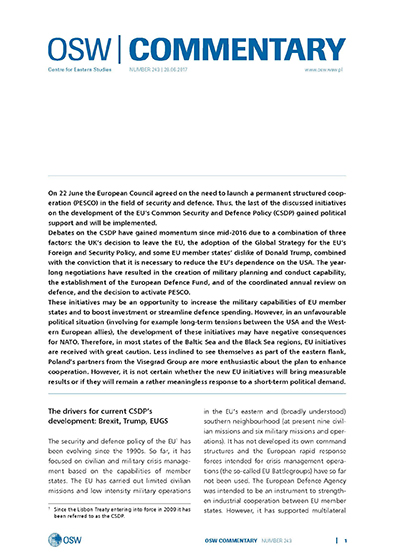
The protests on Kyiv’s Maidan which commenced in November 2013, followed by the conflict in Ukraine’s eastern regions, have redefined the political and social relations between Russia and Ukraine, and have added complexity to the dependences between the Orthodox Churches operating in the two countries. The Kremlin’s policy has put the Russian Orthodox Church–Moscow Patriarchate (ROC) in an awkward position. The ROC is Russia’s largest religious organisation, which also exercises symbolic sovereignty over Ukraine’s most numerous Orthodox community, the Ukrainian Orthodox Church–Moscow Patriarchate (UOC–MP), which since 13 August has had a new leader, Metropolitan Onufry.
More...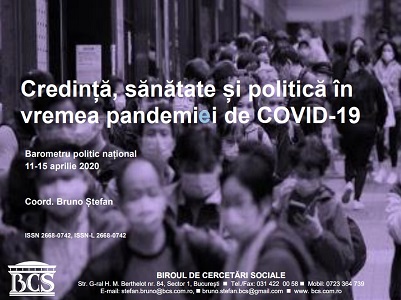
The survey was conducted between April 11-15, 2020 on a sample of 1008 people selected from 116 urban and rural localities in all counties of Romania. He measured people’s religious beliefs (in God, Hell, the Last Judgment, icons, reincarnation), self-perception (lucky, happy, hardworking, patriotic), self-assessment of the health of certain organs or problems (heart, brain, bones, teeth, infections), the perception of the involvement of the authorities in the management of the COVID crisis, the trust in the political leaders, the voting intentions.
More...
Nije nas iznenadilo to što je protekle nedelje Srpska pravoslavna crkva od državnog vrha tražila prekid zabrane kretanja radi održavanja uskršnje liturgije. Ovim zahtevom crkva je zatražila poseban status koji uživa i van vanrednog stanja – poput poreskih povlastica i neiscrpnog i višegodišnjeg finansiranja crkvenih aktivnosti i potreba iz državnog budžeta. Nakon što je epidemiologdr Predrag Kon zapretio ostavkom, a stvarni gospodar epidemiološke zaštite razgovarao sa patrijarhom, crkva je saopštila da će „poštovati državne mere“ u suzbijanju epidemije.prekid zabrane kretanjaprekid zabrane kretanja
More...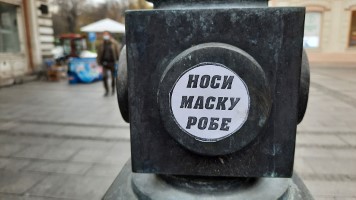
Republika Srbija je svetovna država. Crkve i verske zajednice su odvojene od države. Nijedna religija ne može se uspostaviti kao državna ili obavezna. (Član 11. Ustava Republike Srbije) Premijerka nas je nedavno obavestila da je jedan od prioriteta Vlade – vladavina prava.
More...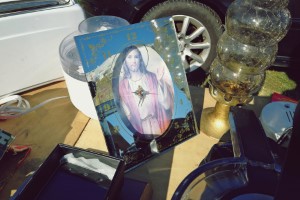
Učiteljica iz jedne novosadske osnovne škole imala je, prošle nedelje, nesvakidašnju ideju kako da se bori protiv korone. Ona je predložila da se učionica u kojoj predaje svakoga dana okadi tamjanom, a da se učenici onda pomole. Predlog je iznela roditeljima u okviru vajber grupe, a njih osamnaest od ukupno dvadeset troje koliko ih je glasalo, izjasnilo se pozitivno. Uprkos većinskoj želji roditelja da se realizuje predložena praksa, uprava škole kategorično je odbacila predlog.
More...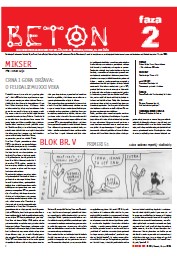
MIKSER, Dušan Grlja: Crna i Gora država– O feudalizmu XXI veka; BLOK BR. V, Studiostrip: Primeri 51; anti-CEMENT, Branislav Dimitrijević: Poznavanje prirode i društva; ŠTRAFTA, Vesna Madžoski: Crni kvadrat, beli okvir; ZID, Mirjana Dragosavljević: Gde budućnost počinje?; TENDERSKA DOKUMENTACIJA, Vladimir Milojković: Zatvor
More...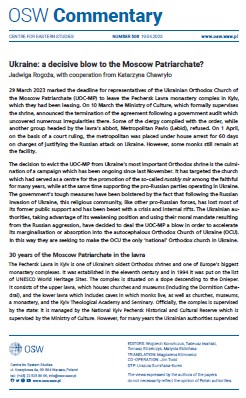
29 March 2023 marked the deadline for representatives of the Ukrainian Orthodox Church of the Moscow Patriarchate (UOC-MP) to leave the Pechersk Lavra monastery complex in Kyiv, which they had been leasing. On 10 March the Ministry of Culture, which formally supervises the shrine, announced the termination of the agreement following a government audit which uncovered numerous irregularities there. Some of the clergy complied with the order, while another group headed by the lavra’s abbot, Metropolitan Pavlo (Lebid), refused. On 1 April, on the basis of a court ruling, the metropolitan was placed under house arrest for 60 days on charges of justifying the Russian attack on Ukraine. However, some monks still remain at the facility.
More...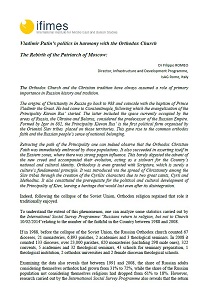
The Orthodox Church and the Christian tradition have always assumed a role of primary importance in Russian history and tradition. The origins of Christianity in Russia go back to 988 and coincide with the baptism of Prince Vladimir the Great. He had come to Constantinople, following which the evangelization of the Principality Kievan Rus’ started. The latter included the space currently occupied by the areas of Russia, the Ukraine and Belarus, considered the predecessor of the Russian Empire. Formed by Igor in 882, the Principality Kievan Rus’ is the first political form organised by the Oriental Slav tribes placed on those territories. This gave rise to the common orthodox faith and the Russian people’s sense of national belonging. Retracing the path of the Principality one can indeed observe that the Orthodox Christian Faith was immediately embraced by those populations. It also succeeded in asserting itself in the Eastern zones, where there was strong pagan influence. This barely digested the advent of the new creed and accompanied their evolution, acting as a stalwart for the Country’s national and cultural identity. Orthodoxy is even granted with Scripture, which is surely a culture’s fundamental principle. It was introduced via the spread of Christianity among the Slav tribes through the creation of the Cyrillic characters due to two great saints, Cyril and Methodius. It also constituted the prerequisite for the political and cultural development of the Principality of Kiev, leaving a heritage that would last even after its disintegration.
More...